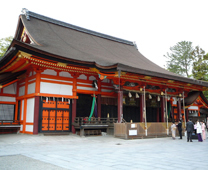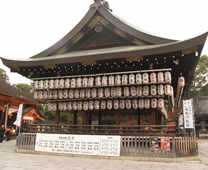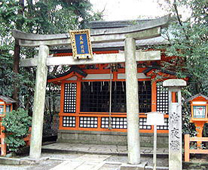
Travel Guide
Yasaka Shrine, once called Gion Shrine, is a Shinto shrine. Founded over 1350 years ago, the shrine is located between the popular Gion and Higashiyama, and is often visited by tourists walking between the two districts.
Yasaka Shrine is an important shrine for Kyoto's inhabitants because it's close to the shopping districts. Some local people call the temple Gion-san with respect. People flock here for weddings, to get their newborn babies blessed, to pray for love, success or just spend a little time among the beautiful surroundings. Note that with lovely lanterns illuminated at night, this is a great place for an evening stroll. It’s also a great place to go on New Year’s Eve or Day, as long as you don’t mind crowds.
The shrine also becomes busy during the cherry blossom season around early April, as the adjacent Maruyama Park is one of the most famous cherry blossom spots in Kyoto.
Yasaka Shrine was dedicated to Susanoo-no-mikoto, Kushiinadahime-no-mikoto, and Yahashira-no-mikogami. Susanoo-no-mikoto is a great god in Japanese mythology, known for his defeat of Yamata-no-orochi (a large serpent with eight heads: a symbol of many disasters), redemption of Kushiinadahime-no-mikoto, and produced the ground great-discernment on the earth.
Complex
The shrine's main hall combines the honden (inner sanctuary) and haiden (offering hall) into a single building. In front of it stands a dance stage with hundreds of lanterns that get lit in the evenings. Each lantern bears the name of a local business in return for a donation.
The buildings at Yasaka Shrine date from 1654 and were built on the order of the shogun of the day. The entrance gate or Ro-mon stands at the top of a flight of stairs and the shrine is protected by the two guardian statutes at each side.
The stone torii gate on the south side is 9.5m in height - one of the largest in Japan and dates from 1646. Two wooden koma-inu (Lion dog guardians) in the shrine are said to have been carved by the celebrated sculptor Unkei, also responsible for many of the statues of Kannon at Sanjusangendo Temple, in the 13th century.
History
Initial construction on the Shrine began in 656. The Shrine became the object of Imperial patronage during the early Heian period. In 965, Emperor Murakami ordered that Imperial messengers be sent to report important events to the guardian kami of Japan. These heihaku were initially presented to 16 shrines; and in 991, Emperor Ichijo added three more shrines to Murakami's list. Three years later in 994, Ichijo refined the scope of that composite list by adding Umenomiya Shrine and Gion Shrine. Most of the buildings that remain today are from a reconstruction in 1654.
From 1871 through 1946, Yasaka Shrine was officially designated one of the Kanpei-taisha, meaning that it stood in the first rank of government supported shrines.
 |
 |
 |
| Main hall | Maiden | Utsukushigozensha Temple |
Travel Advice
Seven mistery legend of Yasaka Shrine
1. Nishiromon (Nishiro Gate)
Nishiromon is the representative gate in Yasaka Shrine. Nishiromon has been designated as important cultural heritage in Japan. It is said that Nishiromon never bear a spider web, even it rains there is no traces of rain on the gate. Since Nishiromon faces Shijo-dori, Nishiromon is the waiting place for friends to gather to view the cherry blossom during the cherry blossom viewing season.
2. Ryuketsu (Dragon well)
It is said that there is a deep-drilled well below the main hall and the well leads to Shinsenen Temple, Toji Temple and Ryugujo (undersea palace).
3. The roar of Dragon
It will echo when clap your hands facing west-side pillar at east-side pillar. It is because the dragon painted on the ceiling is roaring.
4. Tadamori toro (toto is a traditional lantern made of stone)
A toro located in the east of Maiden is call Tadamori toro. At a rainy night in Keikyu period (1113-1118), Emperor Shirakawa saw a ghost on the way to Gion so the Emperor ordered Tadamori to kill it. Tadamori found it was an old monk lighting the toro. People admire Tadamori for looking carefully but not to kill the wrong person. The toro we see today is said to remaine from that night.
5. Futami rock
A rock between the inner temple and outer temple in Daijingu Temple, the Massha (undershrine) of Yasaka Shrine, is called Futami rock. It is said that the rock of the root is deep enough to reach the core of the earth.
6. Biyosui (beauty water)
The temple is dedicated to three Goddesses which are Ichikishimahime, Tagirihime and Tagitsuhime. They are the daughters of Amaterasu-omikami and Susanoo-no-Mikoto. Ichikishimahime is the most beautiful, known as the goddess of beauty, talent and wealth. Utsukushigozensha Temple is the undershrine of Yasaka Shrine known as the beauty of God. It's popular among geisha, maiko and women who want to be beautiful, as well as beauty, hairdressing, cosmetics and other "beauty industry". The spring in front of Utsukushigozensha Temple is called Biyosui (beauty water). It is said that to drop a little water of the spring to the face not only help the health of skin health, the personality can also be beautiful.
7. Yonaki Ishi (a stone that cries at night)
In front of the Hiyoshisha Temple, one of the undershrines of Yasaka Shrine, is a big tree. Next to the tree is a stone called Yonaki Ishi. It is said that the stone cries at night.
Amaterasu-omikami and Susanoo-no-mikoto
Amaterasu-omikami is the goddess of the sun, but also of the universe. Susanoo-no-Mikoto is the Shinto god of the sea and storms.
Somin Shorai
Somin Shorai is a lucky charm based on a folk belief in Japan. In the belief, Somin Shorai was a poor but charitable person. He saved a tourist who was looking for a place to stay the night on his journey. The tourist was actually a famous god Susanoo-no-Mikoto and rejected by a mean, rich person just before, so he thanked and taught Somin how to make a lucky charm which avoids disasters. Later, when a disaster hit the country, only Somin's family was able to survive. Therefore, it is believed that a family which worships Somin Shorai charm avoids all kinds of disasters and thrives forever.
Events
Yasaka Shrine is well known for its summer festival, the Gion Matsuri (Gion Festival), which is celebrated every July. Arguably the most famous festival in the whole country, the Gion Matsuri dates back over a thousand years and involves a procession with massive floats and hundreds of participants. In 869, the omikoshi (portable shrines) of Gion Shrine were paraded through the streets of Kyoto to ward off an epidemic that had hit the city. This was the beginning of the Gion Matsuri, an annual festival that has become world famous.
Other popular festivals held at Gion Shrine include setsubun in early February with an evening bonfire, the Ochatsubo Dochu (Traveling Tea Canisters) festival on May 1 and Shichi-go-san in November.
Ochatsubo Dochu harks back to the Edo Period practice of presenting the new tea harvest from Uji to the shogun. Bearers in period costume carry large ceramic containers containing tea from Kenninji Temple up Yamato-oji, along Shijo to Yasaka Shrine. Read more: http://www.japanvisitor.com/japan-temples-shrines/yasaka-shrine#ixzz39iBTlGRd
| Events in 2020 | ||
| Gion Matsuri | One of the 3 most renowned festivals in Kyoto. Many events are held during the festival. Highlights are Yoi-yama on 16th and Yamahoko-junko on 17th. Also Hanagasa-junko happens on the 24th and ends with the Eki-jinja nagoshi-sai on the 31th. | Jul 1(Wed)~ 31(Fri) |
Visit
| Address | 625 Kitagawa, Gion-cho, Higashiyama-ku, Kyoto-shi, Kyoto | |
| Phone | 075-561-6155 | |
| Admission | Free | |
| Hours | Free | Reception for worship from 9:00 to 14:00 |
| Closed | Open 7 Days a Week | |
| Duration | 20 minutes | |
| Getting There | By Train Take City Bus No.206 from JR Kyoto Station to the Yazakajinja bus stop, then walk approximately 1 minute. 8 minute walk from Kawaramachi Station on Hankyu Railway Kyoto Honsen. 5 minute walk from Gion-shijo Station on Keihan Electric Railway Keihan Honsen. By Car Take Meishin Expressway to the Kyoto-higashi exit. It is approximately 7 kilometers 20 minutes from exit. |
|
| Parking | Paid parking available | |

